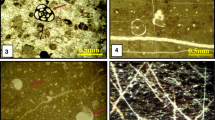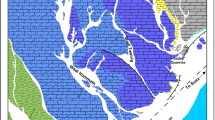Abstract
The Late Cretaceous Simsima Formation is a post-obduction mixed carbonate–sliciclastic sequence exposed in isolated outcrops in the Oman Mountains. This study utilizes an integrated facies analysis to interpret the depositional environment of the Simsima Formation in the Jabel Al-Rawdah section, Oman. The Simsima Formation in the study area is 75 m thick and unconformably overlies the Semail ophiolite complex. The formation consists of six lithofacies, including (i) paraconglomerate, (ii) laminated mudstone, (iii) arenaeous bioclastic grainstone, (iv) bioclastic grainstone, (v) greyish massive pack to rudstone, and (vi) rudist grainstone. The Simsima Formation is highly fossiliferous, containing corals, crinoids, rudists, Larger Benthic Foraminifera (Omphalocyclus macroporus, Siderolites calcitrapoide, and Orbitoides sp.), gastropods, and bivalves. According to petrographic analysis, the fabric texture of limestone is mainly grainstone (lower part), a few packstone intervals (middle part), and boundstone in the upper part of the formation. The most common non-skeletal grains are peloids, a few intraclasts, and coated grains. Terrigenous detritus grains are also present. The lithologic properties, fossil content, and sedimentary structures and textures of the six lithofacies that constitute the formation allow to decipher the deposition of the formation in a well-agitated shallow marine environment. The vertical arrangement of the various lithofacies of the Al-Rawdah section indicates an overall deepening-upward succession. The deposition of the formation was influenced by both tectonic and climatic factors.









Similar content being viewed by others
Data Availability
All data sets used in this study are provided in the paper.
References
Abbasi IA, Salad Hersi O, Al-Harthy A (2014) Late Cretaceous conglomerates of the Qahlah formation, North Oman. Geol Soc Lond Spec Publ 392(1):325–341
Abd-Allah A, Hashem W, Abdelghany O (2013) Structural and tectonostratigraphic evolution of the Upper Cretaceous–Eocene sequence in Malaqet–Mundassah–El Saah Range, Oman Mountains, United Arab Emirates, and Oman. Journal Of African Earth Sciences 79: 111–124
Abbasi R, Piryaei A, Ghorbani M, Mobasheri A (2021) Maastrichtian tectono-sedimentary evolution of the western Fars area (Zagros, SW Iran): insights into a foreland basin deposits. Geopersia 11(2):337–360
Abd-Allah A (2008) Late Cretaceous-Eocene reactivations of the Hatta Shear Zone, Northern Oman Mountains. Int J Geol 2(2):23–32
Abd-Allah A, Hashem W, Abdelghany O (2019) Post-obduction deformations of the northwestern end of the Hatta Shear Zone, El Rawdah area, Northern Oman Mountains. Int J Sci Res 18:31–48
Abdelghany O (2003) Late Campanian-Maastrichtian foraminifera from the Simsima Formation on the western side of the Northern Oman Mountains. Cretac Res 24(4):391–405
Abdelghany O (2006) Early Maastrichtian larger foraminifera of the Qahlah Formation, United Arab Emirates, and Sultanate of Oman border region. Cretac Res 27(6):898–906
Aghaei A, Mahboubi A, Moussavi-Harami R, Heubeck C, Nadjafi M (2012) Facies analysis and sequence stratigraphy of an Upper Jurassic carbonate ramp in the eastern Alborz Range and Binalud Mountains, NE Iran. Facies 59(4):863–889. https://doi.org/10.1007/s10347-012-0339-8
Al-Hashim MH, El-Asmar HM, Abdel-Fattah ZA (2022) Depositional environment and sequence stratigraphy of the Upper Cretaceous Aruma Formation, NE Riyadh, Saudi Arabia. J Afr Earth Sc 188:104479
Al-Khirbash S (2016) Geology, mineralogy, and geochemistry of low-grade Ni-lateritic soil (Oman Mountains, Oman). Chem Erde 76:363–381
Al-Khirbash S, Nasir S, Al-Harthy A, Richard L, Al-Sayigh A, Darkel A, Semhi K (2010) Geology and Ni-Co mineralization of laterites of the Oman Mountains. In: 7th International Symposium on the Eastern Mediterranean Geology, pp 18–22
Alsharhan AS, Ziko A, Shebl HT, Whittle GL (2000) Microfacies and microfabrics of Maastrichtian carbonates, northwestern Oman Mountains, UAE, Tulsa, Oklahoma: UAE Society for Sedimentary Geology 69:129–142
Béchennec F, Roger J, Janjou D, Le Métour J, Wyns R, Beurrier M (1993) Geological map of Mahdah, sheet NG 40–14D2, Scale 1:50000, with explanatory notes. Directorate General of Minerals, Oman Ministry of Petroleum and Minerals, 46
Bilal A, Yang R, Mughal MS, Janjuhah HT, Zaheer M, Kontakiotis G (2022) Sedimentology and diagenesis of the Early-Middle Eocene carbonate deposits of the Ceno-Tethys Ocean. J Mar Sci Eng 10(11):1794. https://doi.org/10.3390/jmse10111794
BouDagher-Fadel MK (2018) Evolution and geological significance of larger benthic foraminifera. UCL Press
Burchette TP, Wright VP (1992) Carbonate ramp depositional systems. Sedimentary Geology 79(1–4): 3–57. https://doi.org/10.1016/0037-0738(92)90003-a
Caus E, Albrich S, Berastegui X, Bernaus JM, Boix C, Villalonga R (2007) Biotic and abiotic events in a shallow carbonate platform (Upper Cretaceous, South Pyrenean Margin). Bull Geol Soc Greece 40:14–20
Dunham RJ (1962) Classification of carbonate rocks. Memoirs. American Association of Petroleum Geologists 1:108–21
El-Saiy A, Jordan B (2007) Diagenetic aspects of tertiary carbonates west of the Northern Oman Mountains, United Arab Emirates. Journal of Asian Earth Sciences 31(1):35–43
Embry AF, Klovan JE (1971) A late Devonian reef tract on northeastern Banks Island, NWT. Bull Can Petrol Geol 19(4):730–781
Erdem ME, Özcan E, Yücel AO, Okay AI, Erbay S, Kayğili S, Yilmaz I (2021) Late Campanian larger benthic foraminifera from the Zekeriyaköy Formation (İstanbul, NW Turkey): taxonomy, stratigraphy, and paleogeography. Turk J Earth Sci 30(1):1–21
Esrafili-Dizaji B, Rahimpour-Bonab H, Mehrabi H, Afshin S, Kiani Harchegani F, Shahverdi N (2015) Characterization of rudist-dominated units as potential reservoirs in the Middle Cretaceous Sarvak Formation, SW Iran. Facies 61(3). https://doi.org/10.1007/s10347-015-0442-8
Flügel E (2010) Carbonate sedimentary rocks. Springer, Berlin
Flügel E (1982) Microfacies analysis of limestones. (K. Christenson., Trans.) Springer, Berlin, 633
Flügel E (2004) Microfacies analysis of carbonate rocks. Analysis, interpretation and application. Springer, Berlin. https://doi.org/10.1007/978-3-662-08726-8
Glennie KW, Boeuf MG, Hughes-Clarke MHW, Moody-Stuart M, Pilaar WF, Reinhardt B (1974) Geology of the Oman Mountains. Verhandelingen Koninklijk Nederlands geologisch mijnbouwkundidg Genootschap, Amsterdam, 31, 423.
Hanna SS (1995) Field guide to the geology of Oman. The Historical Association of Oman, Muscat, Sultanate of Oman. 178
Haq BU, Hardenbol J, Vail PR (1987) Chronology of fluctuating sea levels since the Triassic. Science 235:1156–1167
Hardenbol J, Theirry J, Farley MB, Jacquin T, de Graciansky PC, Vail PR (1998) Mesozoic and Cenozoic sequence chronostratigraphic framework of European Basins. SEPM Spec Publ 60:3–131
Kayğılı S, Yücel A, Abbasi İ, Catanzariti R, Özcan E (2021) A new species of Omphalocyclus Bronn, O. omanensis sp. nov., from the upper Campanian of Oman: phylogenetic and stratigraphic implications. Cretac Res 124:104–801
Métour J, Béchennec F, Chevremont P, Roger J, Wyns R (1992) Geological map of Buraymi, Sheet NG 40–14, Scale 1 250,000, with explanatory notes. Directorate General of Minerals, Oman Ministry of Petroleum and Minerals 89
Mohammed IQ, Farouk S, Lawa F, Alsuwaidi M, Morad S (2020) Upper Cretaceous wedge-top to foredeep architecture in the United Arab Emirates: insights from the Faiyah Anticline. Geol J 56(5):2602–2624. https://doi.org/10.1002/gj.4057
Nolan S, Skelton P, Clissold B, Smewing J (1990) Maastrichtian to early Tertiary stratigraphy and paleogeography of the Central and Northern Oman Mountains. Geol Soc Lond Spec Publ 49(1):495–519
Özcan E, Abbasi İA, Yücel AO, Aşcı SY, Erkızan LS, El-Ghali MAK, Çalışkan D, Gültekin MN, Kayğılı S (2022) First record of the foraminiferal genera Clypeorbis Douvillé and Ilgazina Erdoğan from the Maastrichtian of the Arabian Peninsula (Simsima Formation, North Oman): Paleobiogeographic implications. Cretaceous Research 138:105290. https://doi.org/10.1016/j.cretres.2022.105290
Roger J, Béchennec F, Janjou D, Le Métour J (1993) Geological map of Al Buraymi, Sheet NG 40–14D4, Scale 1 50000, with explanatory notes. Directorate General of Minerals, Oman Ministry of Petroleum and Minerals 49
Salad Hersi O, Abbasi IA, Al-Sayigh A, Al-Sarmi M, El-Ghali M, and Al-Raisi T (2024) Post-Oligocene tectono-eustatic fluctuations and their influence on the stratigraphy of eastern Arabia: the Fars Group of the Batina Coast, Oman. In: Recent research on sedimentology, stratigraphy, paleontology, geochemistry, volcanology, tectonics, and petroleum geology (volume 1) Proceedings of of the 2nd MedGU Conference, Istanbul, Turkey. https://doi.org/10.1007/978-3-031-43222-4
Sanders D (1998) Upper Cretaceous rudist formations. Geol Paläont Mitt Innsbruck 23:37–59
Sayed MSA, Mersal MA (1998) Surface geology of Jebel Rawdah, Oman. Geoarabia 3(3):401–414
Schlüter M, Steuber T, Parente M, Mutterlose J (2008) Evolution of a Maastrichtian-Paleocene tropical shallow-water carbonate platform (Qalhat, NE Oman). Facies 54(4):513–527
Searle M (2007) Structural geometry, style, and timing of deformation in the Hawasina Window, Al Jabal al Akhdar and Saih Hatat culminations, Oman Mountains. Geoarabia 12(2):99–130
Skelton PW, Nolan SC, Scott RW (1990) The Maastrichtian transgression onto the northwestern flank of the Proto-Oman Mountains: sequences of rudist-bearing beach to open shelf facies. Geological Society, London, Special Publications 49(1): 521–547
Smith AB, Morris NJ, Gale AS, Kennedy WJ (1995) Late Cretaceous carbonate platform faunas of the United Arab Emirates-Oman border region. Bull-Nat Hist Mus Geol Ser 51(2)
Tucker ME, Wright VP (1990) Carbonate sedimentology. Oxford, Blackwell Science Ltd, 482 Wright, V. P., & Tucker, M. E. (1990) Carbonate sedimentology. Blackwell scientific publications. pp 1–27
Warrak M (2010) Forced folding of the neoautochthonous Late Cretaceous-Early Tertiary sequence at the western end of the Hatta Zone, Northern Oman Mountains. Arab J Geosci 3(4):369–393
Wilson JL (1975) Carbonate facies in geologic history. Springer Science & Business Media. https://doi.org/10.1007/978-1-4612-6383-8
Wright VP, Burchette TP (1996) Shallow-water carbonate environments. In: Reading HG (ed) Sedimentary environments: processes, facies, and stratigraphy. Blackwell Science, pp 335–394
Acknowledgements
Hamdan Al-Zidi prepared thin sections. The authors express deep gratitude to the editor, and reviewers (Dr. Osman Salad-Hersi from the University of Regina, Canada, Dr. Mohibhllah Kakar from the University of Baluchistan, Pakistan, and an anonymous reviewer) for dedicating their time to assess the manuscript and providing valuable feedback. Their constructive input significantly enhanced the quality of the document.
Funding
This study was conducted through TRC grant # RC/RG-SCI/ETHS/21/01 and the College of Science internal grant # IG/SCI/ETHS/21/02.
Author information
Authors and Affiliations
Corresponding author
Ethics declarations
Competing interests
The authors declare no competing interests.
Additional information
Responsible Editor: Mohamed Khalifa
Rights and permissions
Springer Nature or its licensor (e.g. a society or other partner) holds exclusive rights to this article under a publishing agreement with the author(s) or other rightsholder(s); author self-archiving of the accepted manuscript version of this article is solely governed by the terms of such publishing agreement and applicable law.
About this article
Cite this article
Al-Jabri, M.S., Abbasi, I.A., Hanif, M. et al. Integrated facies analysis of the Late Cretaceous Simsima Formation in northwestern Oman mountain, Jabel Al-Rawdah, Hatta area, Oman. Arab J Geosci 17, 120 (2024). https://doi.org/10.1007/s12517-024-11929-0
Received:
Accepted:
Published:
DOI: https://doi.org/10.1007/s12517-024-11929-0




